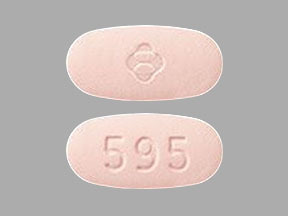Letermovir Dosage
Medically reviewed by Drugs.com. Last updated on Apr 29, 2025.
Applies to the following strengths: 240 mg; 480 mg; 240 mg/12 mL; 480 mg/24 mL; 120 mg; 20 mg
Usual Adult Dose for:
Additional dosage information:
Usual Adult Dose for CMV Prophylaxis
480 mg orally or IV once a day
Comments:
- The IV formulation should be administered at a constant rate over 1 hour.
- Hematopoietic Stem Cell Transplant (HSCT): This drug should be started between Day 0 and Day 28 post-HSCT (before or after engraftment) and should continue through Day 100 post-HSCT.
- In patients at risk for late CMV infection and disease, this drug may be continued through Day 200 post-HSCT.
- Kidney Transplant: This drug should be started between Day 0 and Day 7 and should continue through Day 200 posttransplant.
Uses:
- For the prophylaxis of CMV infection and disease in CMV-seropositive recipients (R+) of an allogeneic HSCT
- For the prophylaxis of CMV disease in kidney transplant recipients at high risk (donor CMV seropositive/recipient CMV seronegative [D+/R-])
Renal Dose Adjustments
CrCl greater than 10 mL/min: No adjustment recommended
CrCl up to 10 mL/min: Insufficient data to make dosing recommendations
Comments:
- Patients with CrCl less than 50 mL/min using the IV formulation: Accumulation of the IV vehicle (hydroxypropyl betadex) may occur; serum creatinine levels should be monitored closely in such patients.
Liver Dose Adjustments
Mild or moderate liver dysfunction (Child-Pugh A or B): No adjustment recommended
Severe liver dysfunction (Child-Pugh C): Not recommended
Dose Adjustments
Coadministration with cyclosporine: Dose should be reduced to 240 mg orally or IV once a day.
Comments:
- If cyclosporine is begun after starting this drug, the next dose of this drug should be reduced to 240 mg once a day.
- If cyclosporine is stopped after starting this drug, the next dose of this drug should be increased to 480 mg once a day.
- If dosing of cyclosporine is interrupted due to high cyclosporine levels, no dose adjustment of this drug is necessary.
Precautions
CONTRAINDICATIONS:
- Coadministration with pimozide, ergot alkaloids
- With cyclosporine: Coadministration with pitavastatin, simvastatin
Safety and efficacy have not been established in patients younger than 18 years.
Consult WARNINGS section for additional precautions.
Dialysis
Insufficient data to make dosing recommendations
Other Comments
Administration advice:
- Injection:
- The diluted solution must be administered through a sterile 0.2 micron or 0.22 micron polyethersulfone (PES) in-line filter; do not administer through a filter other than a sterile 0.2 micron or 0.22 micron PES in-line filter.
- Administer by IV infusion via a peripheral catheter or central venous line; infuse at a constant rate over 1 hour. Do not administer as IV bolus injection.
- Do not coadminister through the same IV line (or cannula) with other drug products and diluent combinations (except those listed as compatible below).
- Only use the IV formulation (which contains hydroxypropyl betadex) in patients unable to take oral therapy; switch patients to oral formulation as soon as they can take oral products.
- Tablets:
- Administer with or without food.
- Swallow tablets whole.
- The oral and IV formulations may be used interchangeably (no dose adjustment needed) at physician's discretion.
- If a dose is missed, take it as soon as remembered; if do not remember until time of next dose, skip the missed dose and return to the regular schedule. Do not double the next dose or take more than the prescribed dose.
Storage requirements:
- Injection (prior to dilution): Store vials at 20C to 25C (68F to 77F); excursions permitted to 15C to 30C (59F to 86F). Store in original carton to protect from light.
- Injection (after dilution): The diluted solution is stable for up to 24 hours at room temperature or up to 48 hours under refrigeration at 2C to 8C (36F to 46F); this time includes storage in the IV bag through the duration of infusion.
- Tablets: Store in original package until use. Store at 20C to 25C (68F to 77F); excursions permitted to 15C to 30C (59F to 86F).
Reconstitution/preparation techniques (injection):
- Dilute before IV use.
- Do not use with IV bags and infusion set materials containing the plasticizer diethylhexyl phthalate (DEHP); only use with IV bags and infusion set materials that are DEHP-free (phthalate-free materials are also DEHP-free).
- The manufacturer product information should be consulted.
IV compatibility:
- COMPATIBLE DILUENTS: 0.9% Sodium Chloride Injection, USP; 5% Dextrose Injection, USP
- COMPATIBLE DRUG PRODUCTS:
- In 0.9% Sodium Chloride Injection, USP: Ampicillin sodium, ampicillin sodium-sulbactam sodium, anti-thymocyte globulin, caspofungin, daptomycin, fentanyl citrate, fluconazole, furosemide, human insulin, magnesium sulfate, methotrexate, micafungin
- In 5% Dextrose Injection, USP: Amphotericin B lipid complex, anidulafungin, cefazolin sodium, ceftaroline, ceftriaxone sodium, doripenem, famotidine, folic acid, ganciclovir sodium, hydrocortisone sodium succinate, morphine sulfate, norepinephrine bitartrate, pantoprazole sodium, potassium chloride, potassium phosphate, tacrolimus, telavancin, tigecycline
- COMPATIBLE IV BAGS AND INFUSION SET MATERIALS:
- IV bag materials: Polyvinyl chloride (PVC), ethylene vinyl acetate (EVA), polyolefin (polypropylene and polyethylene)
- Infusion set materials: PVC, polyethylene (PE), polybutadiene (PBD), silicone rubber (SR), styrene-butadiene copolymer (SBC), styrene-butadiene-styrene copolymer (SBS), polystyrene (PS)
- Plasticizers: Tris (2-ethylhexyl) trimellitate (TOTM), benzyl butyl phthalate (BBP)
- Catheters: Radiopaque polyurethane
- PHYSICALLY INCOMPATIBLE DRUG PRODUCTS: Amphotericin B liposomal, amiodarone hydrochloride (HCl), aztreonam, cefepime HCl, ciprofloxacin, cyclosporine, diltiazem HCl, filgrastim, gentamicin sulfate, levofloxacin, linezolid, lorazepam, midazolam HCl, mycophenolate mofetil HCl, ondansetron, palonosetron
- INCOMPATIBLE IV BAGS AND INFUSION SET MATERIALS: Polyurethane-containing IV administration set tubing, DEHP plasticizers
- Do not mix with other products.
General:
- Injection: A clear colorless solution; may contain a few product-related small translucent or white particles
Monitoring:
- Infections/Infestations: For CMV reactivation in HSCT recipients (upon completion of prophylaxis)
- Renal: Serum creatinine levels in patients with CrCl less than 50 mL/min using the IV formulation
Patient advice:
- Read the US FDA-approved patient labeling (Patient Information).
- Avoid missing doses and complete the entire course of therapy.
- Store tablets in original package until use.
More about letermovir
- Check interactions
- Compare alternatives
- Reviews (1)
- Side effects
- During pregnancy
- Drug class: miscellaneous antivirals
- Breastfeeding
- En español
Patient resources
- Letermovir oral/injection drug information
- Letermovir (Intravenous) (Advanced Reading)
- Letermovir (Oral) (Advanced Reading)
Other brands
Professional resources
Other brands
Related treatment guides
See also:
Further information
Always consult your healthcare provider to ensure the information displayed on this page applies to your personal circumstances.


